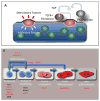Tissue-specific stem cells: lessons from the skeletal muscle satellite cell
- PMID: 22560074
- PMCID: PMC3348769
- DOI: 10.1016/j.stem.2012.04.001
Tissue-specific stem cells: lessons from the skeletal muscle satellite cell
Abstract
In 1961, the satellite cell was first identified when electron microscopic examination of skeletal muscle demonstrated a cell wedged between the plasma membrane of the muscle fiber and the basement membrane. In recent years it has been conclusively demonstrated that the satellite cell is the primary cellular source for muscle regeneration and is equipped with the potential to self renew, thus functioning as a bona fide skeletal muscle stem cell (MuSC). As we move past the 50(th) anniversary of the satellite cell, we take this opportunity to discuss the current state of the art and dissect the unknowns in the MuSC field.
Copyright © 2012 Elsevier Inc. All rights reserved.
Figures




Comment in
-
Inflamm-aging: STAT3 signaling pushes muscle stem cells off balance.Cell Stem Cell. 2014 Oct 2;15(4):401-402. doi: 10.1016/j.stem.2014.09.010. Cell Stem Cell. 2014. PMID: 25280215
References
-
- Abou-Khalil R, Brack AS. Muscle stem cells and reversible quiescence: the role of sprouty. Cell Cycle. 2010;9:2575–2580. - PubMed
-
- Amini-Nik S, Glancy D, Boimer C, Whetstone H, Keller C, Alman BA. Pax7 expressing cells contribute to dermal wound repair, regulating scar size through a beta-catenin mediated process. Stem Cells. 2011;29:1371–1379. - PubMed
Publication types
MeSH terms
Grants and funding
LinkOut - more resources
Full Text Sources
Research Materials
Miscellaneous

